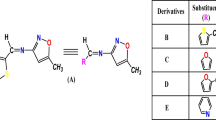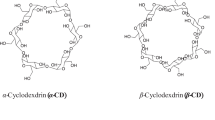Abstract
Novel extended fluorescent styryl derivatives were synthesized from (E)-3-(2-cyclopropyl-4-(4-fluorophenyl)quinolin-3-yl)acrylaldehyde containing quinoline ring with 4-fluorophenyl ring at the 4-position as an electron donor and different active methylene compounds as electron acceptors by conventional Knoevenagel condensation reaction. The UV-Visible absorption and fluorescence emission spectra of the dyes were studied in solvents of differing polarity and the compounds showed polarity sensitive emission properties. The dyes were characterized by the spectral analysis. Thermogravimetric analysis showed these dyes are thermally stable up to 250 °C. Density Functional Theory computations have been used to derive more understanding of structural, molecular, electronic and photophysical parameters of the push-pull dyes. The computed absorption wavelength values are found to be in good agreement with the experimental results. The second order hyperpolarizability (β o) values were computed by Density Functional Theory and found to be in the range of 116.61 × 10−31 to 898.48 × 10−31 e.s.u.









Similar content being viewed by others
References
Fox MA (1992) Introduction - electron transfer: a critical link between subdisciplines in chemistry. Chem Rev 92:365–368. doi:10.1021/cr00011a600
Lakowicz JR (1994) Probe design and chemical sensing topics in fluorescence spectroscopy, 4th edn. 501–504
Balaganesan B, Wen S-W, Chen CH (2003) Synthetic study of tetramethyljulolidine—a key intermediate toward the synthesis of the red dopant DCJTB for OLED applications. Tetrahedron Lett 44:145–147. doi:10.1016/S0040-4039(02)02506-6
Yu G, Gao J, Hummelen JC et al (1995) Polymer photovoltaic cells: enhanced efficiencies via a network of internal donor-acceptor heterojunctions. Science 270:1789–1791. doi:10.1126/science.270.5243.1789
Gold H (1971) The chemistry of synthetic compounds, fluorescent brightening agents. Venkataraman K 535–679
Shirota Y (2000) Organic materials for electronic and optoelectronic devices. J Mater Chem 10:1–25. doi:10.1039/A908130E
Sonawane YA, Phadtare SB, Borse BN et al (2010) Synthesis of diphenylamine-based novel fluorescent styryl colorants by knoevenagel condensation using a conventional method, biocatalyst, and deep eutectic solvent. Org Lett 12:1456–1459. doi:10.1021/ol902976u
Gupta VD, Padalkar VS, Phatangare KR et al (2011) The synthesis and photo-physical properties of extended styryl fluorescent derivatives of N-ethyl carbazole. Dye Pigment 88:378–384. doi:10.1016/j.dyepig.2010.08.013
Hranjec M, Kralj M, Piantanida I et al (2007) Novel cyano- and amidino-substituted derivatives of styryl-2-benzimidazoles and benzimidazo[1,2-a]quinolines. Synthesis, photochemical synthesis, DNA binding, and antitumor evaluation, part 3. J Med Chem 50:5696–5711. doi:10.1021/jm070876h
Zhang N, Zhao Y-Z, Zhang H-S, Wang H (2008) Sensitive determination of aliphatic amines by high-performance liquid chromatography with a new fluorogenic probe 3-(4-fluorinebenzoyl)-2-quinoline carboxaldehyde. J Sep Sci 31:38–46. doi:10.1002/jssc.200700341
Shiraishi Y, Ichimura C, Hirai T (2007) A quinoline–polyamine conjugate as a fluorescent chemosensor for quantitative detection of Zn(II) in water. Tetrahedron Lett 48:7769–7773. doi:10.1016/j.tetlet.2007.09.032
Perin N, Hranjec M, Pavlović G, Karminski-Zamola G (2011) Novel aminated benzimidazo[1,2-a]quinolines as potential fluorescent probes for DNA detection: microwave-assisted synthesis, spectroscopic characterization and crystal structure determination. Dye Pigment 91:79–88. doi:10.1016/j.dyepig.2011.02.003
Ohshima R, Kitamura M, Morita A et al (2009) Design and synthesis of a fluorescent probe for Zn2+, 5,7-Bis(N, N-dimethylaminosulfonyl)-8-hydroxyquinoline-pendant 1,4,7,10-tetraazacyclododecane and Zn2+−dependent hydrolytic and Zn2+−independent photochemical reactivation of its benzenesulfonyl-caged D. Inorg Chem 49:888–899. doi:10.1021/ic901279t
Ou S, Lin Z, Duan C, et al. (2006) A sugar-quinoline fluorescent chemosensor for selective detection of Hg2+ ion in natural water. Chem Commun 4392–4394. doi: 10.1039/B607287A
Mitscher LA (2005) Bacterial topoisomerase inhibitors: quinolone and pyridone antibacterial agents. Chem Rev 105:559–592. doi:10.1021/cr030101q
Wang Z, Vince R (2008) Synthesis of pyrimidine and quinolone conjugates as a scaffold for dual inhibitors of HIV reverse transcriptase and integrase. Bioorg Med Chem Lett 18:1293–1296
Bhanot SK, Singh M, Chatterjee NR (2001) The chemical and biological aspects of fluoroquinolones reality and dreams. Curr Pharm Des 7:331–335. doi:10.2174/1381612013398059
Baba Y, Saha G, Nakao S et al (2000) Asymmetric total synthesis of halicholactone. J Org Chem 66:81–88. doi:10.1021/jo001036c
Boger DL, Hughes TV, Hedrick MP (2001) Synthesis, chemical properties, and biological evaluation of CC-1065 and duocarmycin analogues incorporating the 5-methoxycarbonyl-1,2,9,9a-tetrahydrocyclopropa[c]benz[e]indol-4-one alkylation subunit. J Org Chem 66:2207–2216. doi:10.1021/jo001772g
Graham DW, Ashton WT, Barash L et al (1987) Inhibition of the mammalian.beta.-lactamase renal dipeptidase (dehydropeptidase-I) by Z-2-(acylamino)-3-substituted-propenoic acids. J Med Chem 30:1074–1090. doi:10.1021/jm00389a018
Tsuji T, Nishida S (1987) The chemistry of the cyclopropyl group. Wiley and sons, New York
Rappoport Z (1996) The chemistry of the cyclopropyl group. Wiley, New York
Salaün J (2000) Cyclopropane derivatives and their diverse biological activities. In: Meijere A (ed) Small ring compd. Org. Synth. VI SE - 1. Springer, Berlin
Ellis D, Kuhen KL, Anaclerio B et al (2006) Design, synthesis, and biological evaluations of novel quinolones as HIV-1 non-nucleoside reverse transcriptase inhibitors. Bioorg Med Chem Lett 16:4246–4251. doi:10.1016/j.bmcl.2006.05.073
Fu H, Wu H, Hou X et al (2006) N-Aryl carbazole derivatives for non-doped red OLEDs. Synth Met 156:809–814. doi:10.1016/j.synthmet.2006.04.013
Zhu W, Meng X, Yang Y et al (2010) Bisthienylethenes containing a benzothiadiazole unit as a bridge: photochromic performance dependence on substitution position. Chem Eur J 16:899–906. doi:10.1002/chem.200901855
Xia Z-Y, Zhang Z-Y, Su J-H et al (2010) Robust and highly efficient blue light-emitting hosts based on indene-substituted anthracene. J Mater Chem 20:3768–3774. doi:10.1039/C000092B
Tan Y, Yu J, Gao J et al (2013) A new fluorescent and colorimetric probe for trace hydrazine with a wide detection range in aqueous solution. Dye Pigment 99:966–971. doi:10.1016/j.dyepig.2013.08.008
Jamorski Jödicke C, Lüthi HP (2003) Time-dependent density functional theory (TDDFT) study of the excited charge-transfer state formation of a series of aromatic donor-acceptor systems. J Am Chem Soc 125:252–264. doi:10.1021/ja020361+
Gupta VD, Tathe AB, Padalkar VS et al (2013) Red emitting solid state fluorescent triphenylamine dyes: synthesis, photo-physical property and DFT study. Dye Pigment 97:429–439. doi:10.1016/j.dyepig.2012.12.024
Brouwer AM (2011) Standards for photoluminescence quantum yield measurements in solution ( IUPAC Technical Report ). Pure Appl Chem 83:2213–2228. doi:10.1351/PAC-REP-10-09-31
Frisch MJ, Trucks GW, Schlegel HB, et al. (2009) Gaussian 09 C.01
Treutler O, Ahlrichs R (1995) Efficient molecular numerical integration schemes. J Chem Phys 102:346
Becke A (1993) A new mixing of Hartree-Fock and local density functional theories. J Chem Phys 98:1372
Lee C, Yang W, Parr RG (1988) Development of the Colle-Salvetti correlation-energy formula into a functional of the electron density. Phys Rev B 37:785–789
Valeur B (2001) Molecular fluorescence: principles and applications. Wiley, Weinheim
Lakowicz JR (1999) Principles of fluorescence spectroscopy, 2nd edn. Kluwer, New York
Cossi M, Barone V, Cammi R, Tomasi J (1996) Ab initio study of solvated molecules: a new implementation of the polarizable continuum model. Chem Phys Lett 255:327–335. doi:10.1016/0009-2614(96)00349-1
Tomasi J, Mennucci B, Cammi R (2005) Quantum mechanical continuum solvation models. Chem Rev 105:2999–3094. doi:10.1021/cr9904009
Williams ATR, Winfield SA, Miller JN (1983) Relative fluorescence quantum yields using a computer-controlled luminescence spectrometer. Analyst 108:1067–1071. doi:10.1039/AN9830801067
Suzuki M, Iwasaki H, Fujikawa Y et al (2001) Synthesis and biological evaluations of quinoline-based HMG-CoA reductase inhibitors. Bioorg Med Chem 9:2727–2743. doi:10.1016/S0968-0896(01)00198-5
Suzuki M, Yanagawa Y, Iwasaki H et al (1999) First systematic chiral syntheses of two pairs of enantiomers with 3,5-dihydroxyheptenoic acid chain, associated with a potent synthetic statin NK-104. Bioorg Med Chem Lett 9:2977–2982. doi:10.1016/S0960-894X(99)00519-3
Strehmel B, Rettig W (1996) Photophysical properties of fluorescence probes I: dialkylamino stilbazolium dyes. J Biomed Opt 1:98–109. doi:10.1117/12.227538
Gromov SP, Ushakov EN, Fedorova OA et al (2003) Novel photoswitchable receptors: synthesis and cation-induced self-assembly into dimeric complexes leading to stereospecific [2+2]-photocycloaddition of styryl dyes containing a 15-crown-5 ether unit. J Org Chem 68:6115–6125. doi:10.1021/jo034460x
Chen C-T, Chiang C-L, Lin Y-C et al (2003) Ortho-Substituent effect on fluorescence and electroluminescence of arylamino-substituted coumarin and stilbene. Org Lett 5:1261–1264. doi:10.1021/ol034268h
Vidya S, Ravikumar C, Hubert Joe I et al (2011) Vibrational spectra and structural studies of nonlinear optical crystal ammonium D, L-tartrate: a density functional theoretical approach. J Raman Spectrosc 42:676–684. doi:10.1002/jrs.2743
Chunlong Z, Nianchun M, Liyun L (1993) An investigation of the thermal stability of some yellow and red azo pigments. Dye Pigment 23:13–23. doi:10.1016/0143-7208(93)80020-2
Acknowledgments
The authors are greatly thankful to TIFR, SAIF-I.I.T. Mumbai for recording the 1H-NMR and Mass spectra. One of the authors Mininath S. Deshmukh is grateful to CSIR for financial support.
Author information
Authors and Affiliations
Corresponding author
Electronic supplementary material
Below is the link to the electronic supplementary material.
ESM 1
(DOCX 3.43 mb)
Rights and permissions
About this article
Cite this article
Deshmukh, M.S., Sekar, N. Novel Twisted Intramolecular Charge Transfer (TICT) Extended Fluorescent Styryl Derivatives Containing Quinoline Electron Releasing Moiety. J Fluoresc 24, 1811–1825 (2014). https://doi.org/10.1007/s10895-014-1470-4
Received:
Accepted:
Published:
Issue Date:
DOI: https://doi.org/10.1007/s10895-014-1470-4




